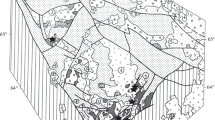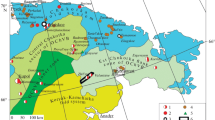Abstract
This paper discusses mineralogic and geochemical features of dominantly silver mineralization in secondary quartzites of the Kyplatap volcanic field (KVF) confined to the southeastern flank of the eponymous intrusive dome structure (IDS) that complicates the Palyavaam–Pykarvaam volcano-tectonic depression which is part of the Chaun zone of the Central Chukchi sector of the Okhotsk–Chukchi volcanogenic belt (OChVB). The Kyplatap IDS was formed as a large laccolite-like subvolcanic body intruded into the Alkakvun rhyolites and trachyrhyolites. The KVF contains an abundance of secondary quartzites that compose both linear zones along faults mostly northeast striking and fault-bounded isometric fields. Potential ore bodies are represented by linear zones of crushed and brecciated secondary quartzites accompanied by quartz veinlets and veins. The ore bodies are long up to 200 m and 2–5 m thick. Spotty, veinlet-impregnated, and brecciated structures predominate in the ore bodies. The ore mineralization is mostly impregnated, less frequently in veinlets. The main vein minerals are quartz (30–70%), hydromica (15–20%), sericite, kaolinite, adularia, ferrous carbonate, zircon, chlorite, and alunite. The main ore minerals are pyrite, arsenopyrite, acanthite, polybasite, pearceite, and native silver. The typomorphic feature of the mineralization is thin intergrowths of silver sulfosalts, native silver, and iron hydroxides. We note that dominantly silver mineralization in secondary quartzites within the OChVB was found for the first time ever. The results of surveys classify the Kyplatap ore occurrence as a gold-silver mineral type deposit (Au/Ag = 1 : 450 on average) of the selenium subtype because of considerable admixture of selenium in the ore minerals. The occurrence of Ag mineralization in secondary quartzites and mudstones may provide evidence that it belongs to the high-sulfidation epithermal class. These features of the KVF epithermal mineralization are largely similar to the formation of siliceous and quartz–alunite lithocaps that are formed above degassing intrusions. In such conditions, the HS-type ore-bearing fluids are either not formed in the system or did not reach the epithermal depths. The ore field is poorly or moderately eroded, what is indicated by a practically complete absence of minerals of the polymetallic association and by the dominance of acanthite and silver sulfosalts over native phases.







Similar content being viewed by others
REFERENCES
Arribas, A., Characteristics of high-sulfidation epithermal deposits, and their relation to magmatic fluid, in Magmas, Fluids, and Ore Deposits, Thompson, J.F.H., Ed., Mineralogical Association of Canada, 1995, Short Course Series 23, pp. 419–454.
Belyi,V.F., Geologiya Okhotsko-Chukotskogo vulkanogennogo poyasa (The Geology of the Okhotsk–Chukchi Volcanogenic Belt), Magadan: SVKNII DVO RAN, 1994.
Bortnikov, N.S., Volkov, A.V., Savva, N.E., Prokofiev, V.Yu., Kolova, E.E., Dolomanova-Topol, A.A., Galyamov, A.L., and Murashov, K.Yu., Epithermal Au–Ag–Se–Te deposits in Chukotka (the Arctic zone of Russia): Metallogeny, mineral parageneses, and fluid regime, Geol. Geofiz., 2022, vol. 63, no. 4, pp. 541–568.
Catchpole, H., Kouzmanov, K., and Fontbote, L., Copper-excess stannoidite and tennantite-tetrahedrite as proxies for hydrothermal fluid evolution in a zoned Cordilleran type base-metal district, Morococha, Central Peru, Can. Min., 2012, vol. 50, pp. 719−743.
Hedenquist, J.W., Browne, P.R., and Allis, R.G., Epithermal Gold Mineralization, Wairakei, New Zealand, 1988.
Hedenquist, J.W., Arribas, A. Jr., and Reynolds, T.J., Evolution of an intrusion-centered hydrothermal system: Far Southeast-Lepanto porphyry-epithermal Cu-Au deposits, Philippines, Econ. Geol., 1998, vol. 93, pp. 373–404.
Hedenquist, J.W., Arribas, A., and Gonzalez-Urien, E., Exploration for epithermal gold deposits, in Gold in 2000, SEG Short course, Tahoe, Nevada, 2000, pp. 245–277.
Lugov, S.F., Makeev, B.V., and Potapova, T.M., Zakonomernosti formirovaniya i razmeshcheniya olovorudnykh mestorozhdenii Severo-Vostoka SSSR (Patterns in the Formation and Location of Tin Deposits in the Northeastern USSR), Moscow: Nedra, 1972.
Mishin, L.F., Secondary quartzites and heir relation to gold mineralization at the Svetloe deposit (Ulya depression, Okhotsk–Chukchi volcanogenic belt), Tikh. Geol., 2011, vol. 30, no. 4, pp. 32‒48.
Petrov, S.F., Material composition, structure and texture of gold–silver mineralization in the Kyplatap volcano-plutonic structure, in Mineralogiya i geneticheskie osobennosti mestorozhdenii zolota i serebra (The Mineralogy and Genetic Features of Gold–Silver Deposits), Magadan: SVKNII DVO RAN, 1996, pp. 105–119.
Savva, N.E., Bryzgalova, I.A., and Tyukova, E.E., The tin porphyry formation in the Karamken region, Vestnik SVNTs DVO RAN, 2009, no. 4, pp. 2–14.
Sillitoe, R.H., Exploration of porphyry copper lithocaps, Australasian Institute of Mining and Metallurgy Publication Series, 1995, no. 9, pp. 527–532.
Sokolov, S.D., Bondarenko, G.E., Morozov, O.L., and Grigor’ev, V.N., The transition zone between the Asian continent and the northwest Pacific during Late Jurassic/Early Cretaceous time, in Teoreticheskie i regional’nye problemy geodinamiki (Theoretical and Regional Problems of Geodynamics), Moscow: Nauka, 1999, pp. 30–82.
Tikhomirov, P.L., Prokofiev, V.Yu., Kalko, I.A., Apletalin, A.V., Nikolaev, Yu.N., Kobayashi, K., and Nakamura, E., The postcollisional magmatism in western Chukotka and the Early Cretaceous tectonic rearrangement in Northeast Asia, Geotektonika, 2017, no. 2, pp. 32–54.
Volkov, A.V., Savva, N.E., Sidorov, A.A., Chizhova, I.A., Kolova, E.E., and Alekseev, V.Yu., The Agan epithermal gold–silver deposit and perspectives for detecting mineralization of the high-sulfidation type in Northeast Russia, Geologiya Rudnykh Mestorozhdenii, 2015, vol. 57, no. 1, pp. 25–47.
White, N.C. and Hedenquist, J.W., Epithermal gold deposits: Styles, characteristics and exploration, SEG Newsletter, 1995, vol. 23, pp. 1, 9–13.
Funding
This work was supported through the state assignment at the IGEM RAS.
Author information
Authors and Affiliations
Corresponding authors
Additional information
Translated by A. Petrosyan
Rights and permissions
About this article
Cite this article
Pilitsyn, A.G., Volkov, A.V., Savva, N.E. et al. Epithermal Ag–Au Mineralization in the Kyplatap Volcanic Field, Central Chukotka. J. Volcanolog. Seismol. 16, 397–408 (2022). https://doi.org/10.1134/S0742046322060057
Received:
Revised:
Accepted:
Published:
Issue Date:
DOI: https://doi.org/10.1134/S0742046322060057




